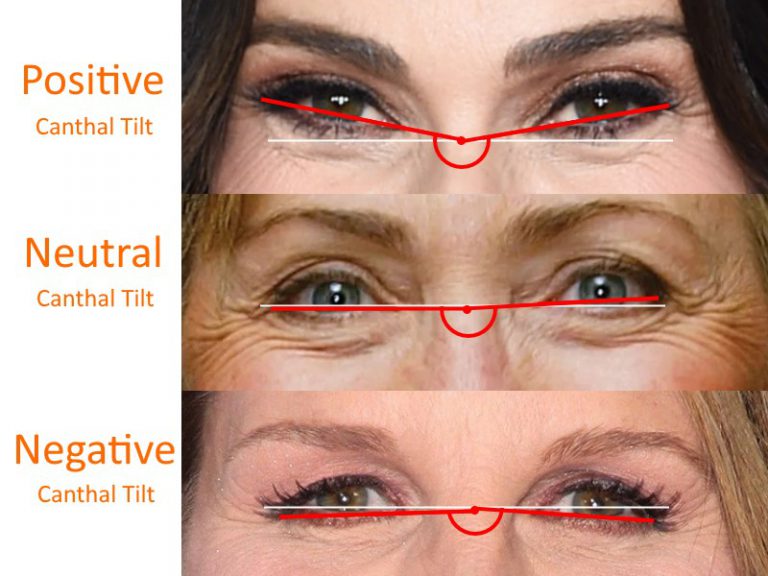Canthal tilt refers to the angle formed between the inner and outer corners of the eyes, a subtle yet significant aspect of facial aesthetics. This feature has gained increasing attention in the fields of beauty, plastic surgery, and even anthropology. The tilt can affect how others perceive a person's attractiveness, youthfulness, and even emotional expressions. Understanding canthal tilt can provide insight into the nuances of human beauty and how slight variations can influence perceptions widely.
The concept of canthal tilt is not just limited to cosmetic discussions; it also plays a crucial role in various cultures and their standards of beauty. For instance, in some societies, a higher canthal tilt is associated with youth and vitality. In contrast, a flatter tilt may be perceived as more mature or wise. The significance of canthal tilt extends beyond aesthetics, touching on cultural beliefs and psychological interpretations of beauty.
Furthermore, the canthal tilt can be an essential factor in surgical procedures, particularly in eye surgeries and facial reconstructive operations. Surgeons often consider this angle when planning operations to ensure that the desired aesthetic outcomes are achieved, ultimately enhancing the patient's overall facial harmony. With its multifaceted implications, understanding canthal tilt is crucial for anyone interested in beauty, medicine, or cultural studies.
What is Canthal Tilt?
Canthal tilt is the angle formed between the inner (medial) and outer (lateral) canthi of the eyes. It is typically measured using a straight line drawn from the medial canthus to the lateral canthus and comparing that angle to the horizontal plane of the face. A positive canthal tilt occurs when the outer canthus is higher than the inner canthus, while a negative tilt is when the outer canthus is lower. This angle can significantly impact facial harmony and aesthetic appeal.
Why is Canthal Tilt Important in Aesthetics?
Canthal tilt plays a pivotal role in the perception of beauty. Studies have shown that individuals with a moderate positive canthal tilt are often rated as more attractive. Here are some reasons why canthal tilt is essential:
- It contributes to the overall symmetry of the face.
- Affects the perceived age of an individual.
- Influences emotional expressions and their interpretations.
- Can impact the effectiveness of cosmetic procedures.
How Does Canthal Tilt Vary Across Different Ethnicities?
Canthal tilt can differ significantly among various ethnic groups due to genetic factors. For instance:
- **East Asian populations** often exhibit a more pronounced upward canthal tilt.
- **Caucasian individuals** may display a flatter angle.
- **African ethnic groups** can show a wider range of canthal tilts.
These variations can contribute to the rich diversity of facial aesthetics globally and highlight the importance of understanding canthal tilt in a multicultural context.
How Can Canthal Tilt Be Measured?
Measuring canthal tilt can be performed using various methods, including:
- **Clinical assessments** by trained professionals.
- **Photographic analysis** using standardized facial images.
- **3D imaging** technology for precise measurements.
Each method has its advantages, and the choice often depends on the context in which the measurement is needed, whether for surgery or aesthetic evaluations.
What Are the Surgical Implications of Canthal Tilt?
Surgeons often consider canthal tilt in various procedures like blepharoplasty or canthoplasty. The goals of these surgeries usually include:
- Enhancing the natural beauty of the eyes.
- Creating a more youthful appearance.
- Correcting functional issues related to eyelid positioning.
By understanding and adjusting the canthal tilt during surgery, surgeons can achieve more aesthetically pleasing results for their patients.
Can Canthal Tilt Change Over Time?
Yes, canthal tilt can change over time due to various factors such as aging, environmental influences, and even lifestyle choices. As a person ages, skin elasticity decreases, which can lead to changes in the eye area. Additionally, external factors like sun exposure and smoking can also influence the appearance of canthal tilt.
Who is a Celebrity Known for Their Canthal Tilt?
One celebrity often noted for their distinctive canthal tilt is the actress **Angelina Jolie**. Her eyes are frequently cited in discussions about attractive canthal tilt, contributing to her iconic status in Hollywood.
| Personal Details | Bio Data |
|---|---|
| Name | Angelina Jolie |
| Date of Birth | June 4, 1975 |
| Nationality | American |
| Profession | Actress, Filmmaker, Humanitarian |
What Makes Angelina Jolie’s Canthal Tilt Unique?
Angelina Jolie's canthal tilt is often described as moderately positive, giving her a youthful and alluring appearance. Her eye shape, combined with the tilt, enhances her expressions and plays a significant role in her on-screen charisma. The impact of her canthal tilt has made her a subject of study in beauty standards and aesthetics.
Can Canthal Tilt Be Corrected or Enhanced?
Yes, canthal tilt can be enhanced or corrected through surgical procedures. Options include:
- **Canthoplasty**: A procedure to adjust the canthal tilt.
- **Blepharoplasty**: Eyelid surgery that can subtly modify the tilt.
- **Injectables**: Fillers that can enhance the overall appearance of the eyes.
These options allow individuals to achieve their desired aesthetic goals while considering the natural proportions of their facial features.
Conclusion: The Significance of Canthal Tilt in Beauty and Aesthetics
In summary, canthal tilt is a crucial aspect of facial aesthetics that influences perceptions of beauty across cultures. Understanding this concept can not only enhance our appreciation of beauty but also guide individuals in making informed decisions about cosmetic procedures. As we continue to explore the complexities of human attractiveness, the canthal tilt will remain an essential topic of discussion in both medical and aesthetic fields.
Also Read
Article Recommendations


ncG1vNJzZmivp6x7tMHRr6CvmZynsrS71KuanqtemLyue8Clo6edp6iDcK%2FAp6uhmZxiwaq402efraWc